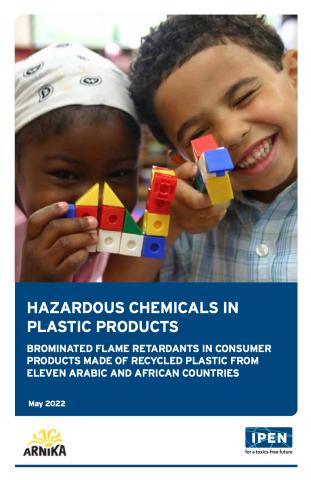Chemical Health Hazards Found in Plastic Products from 11 African and Arabic Countries

For immediate release
Contact: RNDr. Jindrich Petrlik, Program Director, Arnika - Toxics and Waste Programme, IPEN advisor on dioxins and waste
+420.603582984 jindrich.petrlik@arnika.org
Environmental groups call for support for strict limits on toxic chemicals in waste as proposed by African countries
Tunis, Yaoundé, Gothenburg, Prague Independent laboratory testing has found high levels of toxic flame retardant chemicals and brominated dioxins, including substances banned under international agreements, in toys, kitchen utensils and other consumer products made from recycled plastics. According to a new report released today by Arnika and IPEN, the testing of the products purchased from 11 African and Arabic countries showed that 61 products contained levels of brominated flame retardants (BFRs) above the protective limits called Low POPs Content Levels (LPCLs) proposed by African countries for defining hazardous waste under the Basel Convention.
Among the recycled plastic products that tested positive for the highest concentrations of BFRs, brominated dioxins, and other highly toxic chemicals were
- A toy car and two other toys purchased in Jordan
- Two hair accessories purchased in Morocco
- A kitchen knife purchased in Tunisia
- Three hair accessories purchased in Kenya
- A toy purchased in Ethiopia
- A cup for pencils (office supplies) purchased in Tanzania
“Brominated flame retardants and dioxins are highly toxic chemicals that have no place in our children’s toys or our homes,” said Jindrich Petrlik, IPEN advisor on dioxins and waste, Program Director, Arnika - Toxics and Waste Programme and lead author of today’s report.
“Dozens of studies have linked these chemicals to cancer, harms to children’s brain development, infertility and other serious health problems. Our findings show how plastic can poison the circular economy and demonstrate the urgent need for stricter POPs limits globally to ensure that these dangerous chemicals do not contaminate the recycling chain,” saidSemiaGharbi, High qualified teacher in Tunis, environmental specialist, and leader of the Association de l'EducationEnvironnementale pour les Futures Générations (AEEFG).
Hazardous Chemicals in Plastic Products
Report on Brominated Flame Retardants (BFRs) in Consumer Products Made of Recycled Plastic from Eleven Arabic and African Countries
IPEN, Arnika and their partners purchased 434 black plastic toys, hair accessories, kitchen utensils and other products in 11 countries: Burkina Faso, Cameroon, Egypt, Ethiopia, Gabon, Jordan, Kenya, Morocco, Syria, Tanzania, and Tunisia. The groups tested products using X-ray fluorescence (XRF) to look for bromine and antimony, which are chemical markers for harmful flame retardant chemicals.
The XRF screening identified 83 positive samples which were then sent to an independent laboratory for a more detailed chemical analysis. The lab tested for BFRs, and some products were also tested for brominated dioxins, which are extremely hazardous chemicals that sometimes occur as impurities in plastics that contain BFRs.
The lab results found that BFRs bannedas persistent organic pollutants (POPs) under the Stockholm Convention can be found in consumer products from markets in Africa and the Arabic region, and that many products contain dangerously high concentrations of these and other harmful chemicals. The testing found:
- All 83 products contained toxic BFRs. If these products had been made of new (virgin) plastics rather than recycled plastic, 76 of them would exceed the EU safety standard of 10 parts per million (ppm) for POPs in virgin plastic.
- Chemical flame retardants called PBDEs and/or HBCD, substances banned under the Stockholm Convention, were found in all 83 products. The highest levels of PBDEs were in toys, while the highest concentration of HBCDs was in kitchen utensils.
- Very high levels of brominated dioxins were found in all nine products tested for these chemicals – the concentrations of dioxin were similar to the amount found in hazardous waste. A recent study found that children who ingest tiny pieces of plastic toys may be exposed to nine times more dioxin than the WHO daily safety standards. A level exceeding eight thousands pg TEQ/g measured in a Rubik’s-like cube purchased in Jordan is the highest ever measured level of brominated dioxins in a toy.
- Many products contained novel BFRs from the same chemical families as those that have already been banned, raising concerns that these products likely pose similar health hazards and demonstrating that chemicals should be regulated with a class-based approach rather than as individual compounds.
There are currently no official limits on the content of BFRs in products or waste in the African and Arabic countries. However, the African region has advocated for stricter limits for PBDEs in waste under the Basel Convention, to stop imports of hazardous PBDE-containing e-waste into their countries and to end recycling of waste into new products.
Flame retardants are not typically intentionally added to new plastics used for toys or other consumer products, as they would serve no purpose in these applications. Given the high concentration of BFRs (and of older, banned BFRs) found in the products, the researchers say that the products are likely made of recycled plastic from plastic e-waste, end-of-life vehicles (ELVs), and other products in which BFRs were intentionally added to plastics.
The problem of toxic BFRs contaminating toys and other consumer products grew worse beginningin 2009, when BFRs banned under the Stockholm Convention were granted an exemption for recycling, prompted by developed countries looking for an exception that would allow them to export their plastic waste as recycled material.
“Africa has become a destination of illegal toxic waste exports and, as this study shows, toxic chemicals are also present in toys, kitchen utensils, and other consumer products sold at African and Arabic region markets,” concluded Gilbert Kuepouo, a leader of the Centre de Recherche et d‘Education pour le Développement (CREPD), civil society organization in Cameroon.
IPEN, Arnika, and eleven organizations who co-authored the study recommend:
- Stricter Low POPs Content Levels (LPCLs) should be applied to waste to stop the flow of e-waste and ELVs plastic into new products made of recycled plastic. Nations globally should call for stricter limits for POPs in waste in both the Basel and Stockholm Conventions, which will help prevent the use of recycled plastics containing BFRs and dioxins. IPEN and Arnika support the LPCL of 50 ppm proposed for the Basel Convention by African countries.
- E-waste and ELVs plastic containing high levels of toxic flame retardants should be banned from entering the recycling chain. The loophole allowing exports of nonfunctional electronics under the Basel Conventionneeds to be closed and stricter standards for the definition of hazardous wastes must be established under both the Basel and Stockholm Conventions.
- BFRs should be listed as a class under the Stockholm Convention. Adding these chemicals as individual substances could continue to put human health at risk for decades.
- Brominated dioxins should be added on the list of unintentionally produced POPs regulated by the Stockholm Convention. Brominated dioxins were found in various environmental samples. Their levels in food and consumer products are worrying, and showing they require global regulation as similar chlorinated dioxins already listed in Annex C to the Stockholm Convention.
###

